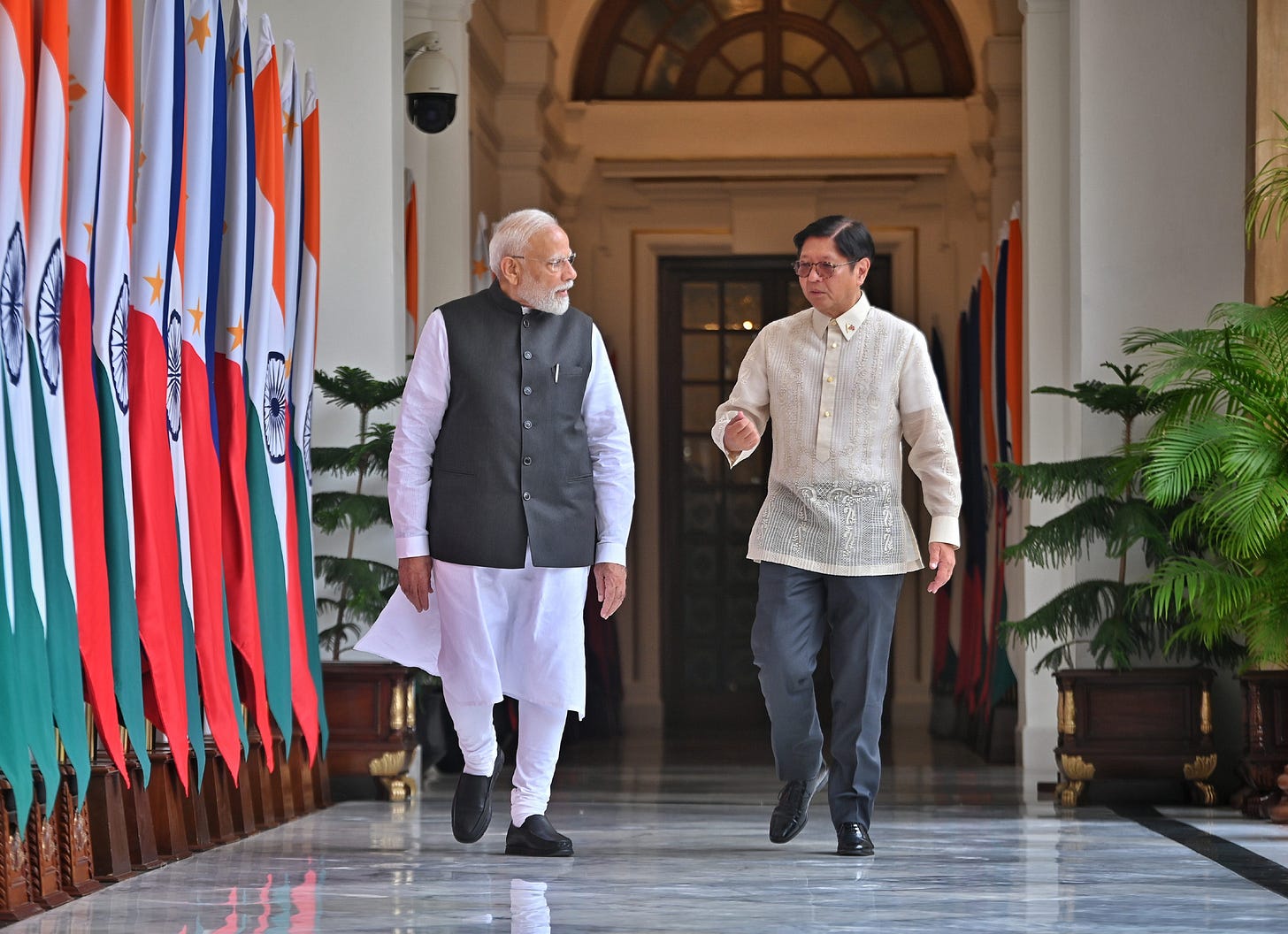🗞️India-Philippines ties now strategic partnership on upward trajectory
By Rahul Mishra, Jawaharlal Nehru University, New Delhi
Today’s email is brought to you by Empower your podcasting vision with a suite of creative solutions at your fingertips.

This August, the visit of Philippine President Ferdinand Marcos Jr. to India marked a historic milestone in the relations between the two nations. The President’s visit, which took place between August 4-8, was the first such state visit since 2007.
On August 5, India and the Philippines formally elevated their ties to a Strategic Partnership, backed by a comprehensive bilateral Plan of Action (2025–2029) signed in New Delhi.
In all, 13 memoranda and agreements were signed during Marcos Jr.’s visit. The partnership spans defence, maritime cooperation, trade, digital technologies, tourism, space cooperation, culture and science.
However, the transition from a prolonged historic stasis to the current phase of strategic dynamism has not been sudden. While India and the Philippines established bilateral diplomatic relations in 1949, thanks to Cold War politics, for decades, their partnership remained largely symbolic—anchored in mutual goodwill but unfulfilled potential.
Initial limitations were rooted in geographical distance, divergent regional priorities and systemic constraints. Over time, however, India’s Look East policy, re-branded in 2014 as the Act East policy, began paving the way for more meaningful engagement through ASEAN frameworks, and India’s initiatives such as the Indo-Pacific Oceans Initiative and Security and Growth for All in the Region, whose acronym SAGAR means ocean in multiple Indian languages. This was upgraded to MAHASAGAR, meaning the great ocean, in March 2025. The expanded acronym stands for Mutual and Holistic Advancement for Security and Growth Across Regions.
As India and the Philippines celebrate 75 years of their bilateral ties, they stand stronger together at the cusp of making qualitative leaps in their relationship.
Defence ties key
Unlike several of its Southeast Asian peers, the Philippines does not have a strong trade relationship with India. The defence and security partnership has thus become the central pillar of the New Delhi-Manila strategic alignment.This is aptly reflected in the agreement on the sale of BrahMos supersonic cruise missile systems to the Philippines. This makes it the first country to procure these missiles from India.
India’s BrahMos cruise missile system, delivered in two batches (first in April 2024; second in April 2025), now empowers the Philippine Marine Corps with advanced coastal defence capability. This was India’s first major defence export.
During Marcos’ recent visit, Prime Minister Narendra Modi stated that defence cooperation is “a symbol of deep mutual trust.” In turn, Marcos emphasised the Philippines as a vital partner in India’s Act East and “Mahasagar” vision. Manila is also eyeing procurement of the Akash surface-to-air missile system from India.
Truth matters. Quality journalism costs.
Your subscription to Mencari directly funds the investigative reporting our democracy needs. For less than a coffee per week, you enable our journalists to uncover stories that powerful interests would rather keep hidden. There is no corporate influence involved. No compromises. Just honest journalism when we need it most.
Not ready to be paid subscribe, but appreciate the newsletter ? Grab us a beer or snag the exclusive ad spot at the top of next week's newsletter.
Strategic calculus and China
On the eve of President Marcos’ visit, the Indian and Philippine navies conducted their first-ever joint exercises in the South China Sea on August 3-4. The drills were held inside the Philippine Exclusive Economic Zone, as part of Manila’s broader efforts to counter China’s maritime assertiveness.
India deployed three warships – INS Delhi, INS Shakti, and INS Kiltan – while the Philippines fielded BRP Miguel Malvar and BRP Jose Rizal. Chinese vessels reportedly followed the Indian-Philippine flotilla.
This shift signals a strategic evolution in India’s posture toward the Indo‑Pacific. Barring a few exceptions, India had previously avoided direct mentions of the South China Sea. However, New Delhi now explicitly endorses adherence to the 2016 South China Sea arbitration award, drawing focus on upholding a rules-based maritime order.
For India, the South China Sea issue is no longer a peripheral concern, but is integral to its maritime and economic security as well as its regional leadership claims. The partnership with the Philippines is a tangible expression of India’s Indo‑Pacific ambitions.
India’s presence there through joint naval patrols and supplying BrahMos to the Philippines reflects an operational follow-through, not just a diplomatic alignment. The aim is deterrence and presenting a viable counterweight to China’s claims in a region critical to global trade, through which about US$3 trillion worth of goods transit annually.
Manila’s pursuit of deeper ties with extra-regional partners such as India represents a deliberate move to reduce dependence on any single ally (for example, the US), and forge multi-directional security and economic collaborations.
Looking at the South China Sea (or West Philippine Sea, as the part within Philippines’ exclusive economic zone is called) issue from the Philippine perspective, it is clear that — barring perhaps Vietnam on occasion — no country has faced as much harassment over territorial claims at the hands of China as the Philippines has.
Recognising the need to balance China’s assertiveness, both countries are prioritising maritime cooperation, information sharing and defence engagements to protect a rules-based order in the area.
Diversifying its security and defence partnerships would not only reduce the Philippines’ dependency on any single country but also empower the Philippines and India to navigate the complex interplay of regional strategic dynamics effectively.
Beyond security
This strategic realignment extends into non-military domains too. For instance, India and the Philippines announced visa-free entry for Indian tourists and free e-visas for Filipino nationals, alongside plans for direct Delhi–Manila flights, expected to expand bilateral tourism and people-to-people exchanges. It has not gone unnoticed in Manila how Thailand and Malaysia offered visa-free entry to Indian tourists and as a result, saw great benefits in tourism. These recent moves promise to further strengthen people-to-people linkages between the two countries. .
The two sides have also agreed to launch a preferential trade negotiation, as bilateral trade remains modest (US$3.3 billion in 2024), but has abundant room for growth. This is in tune with the ongoing review of the ASEAN-India Free Trade Agreement that was implemented in 2010. India-Philippines collaboration frameworks span space exploration, digital innovation, culture, health and agriculture, all underpinned by the 2025–29 Plan of Action. India’s strengths including IT, digital inclusion, pharmaceuticals, and space, align closely with Philippine development goals, positioning the partnership for substantive impact beyond security.
Once characterised by distant potential and limited interaction, the bilateral relationship between India and the Philippines is now evolving into a strong strategic partnership. In a changing Indo-Pacific region marked by increasing great-power rivalry, this partnership stands to benefit India’s pursuit of its strategic objectives, and the Philippines’ efforts for strategic diversification.
Dr Rahul Mishra is Associate Professor at the Centre for Indo-Pacific Studies, SIS, JNU, India, and a Senior Research Fellow at the German-Southeast Asian Centre of Excellence for Public Policy and Good Governance, Thammasat University, Thailand. He was formerly Director of the Centre for ASEAN Regionalism Universiti Malaya (CARUM), Malaysia. He is the Series Editor of the Palgrave Series in Indo-Pacific Studies. He can be reached at rahul.seas@gmail.com
Originally published under Creative Commons Attribution 4.0 by 360info™.
Got a News Tip?
Contact our editor via Proton Mail encrypted, X Direct Message, LinkedIn, or email. You can securely message him on Signal by using his username, Miko Santos.
More on Mencari :
The Mencari AU readers receive journalism free of financial and political influence.
We set our own news agenda, which is always based on facts rather than billionaire ownership or political pressure. Despite the financial challenges that our industry faces, we have decided to keep our reporting open to the public because we believe that everyone has the right to know the truth about the events that shape their world.
Thanks to the support of our readers, we can continue to provide free reporting. If you can, please choose to support The Evening Post Australia.
It only takes a minute to help us investigate fearlessly and expose lies and wrongdoing to hold power accountable. Thanks!







